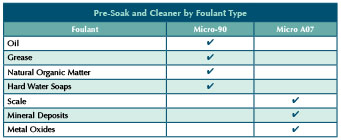Across both water treatment and chemical processing plants, keeping equipment clean is one of the keys to achieving a manufacturer’s promised efficiency standards and power outputs. However, plant managers are sometimes reluctant to incur downtime costs associated with regular cleaning and push the envelope for a perceived short-term gain. The chemists at International Products Corporation saw this problem and have designed products—such as Micro-90®, a concentrated cleaning solution, and Micro® AO7, a concentrated citric acid cleaner—that offer benefits of effective cleaning that can be included in a regularly scheduled maintenance program and of quick application when necessary conditions arise. Below is a ten-step list for clean-in-place (CIP) guidelines for filter membrane systems.
1. When one of the following conditions occur, a cleaning should be done:
- Flux rate decreases by 10 percent.
- Trans-membrane pressure (TMP) increases by 10 percent.
- Permeate water quality decreases by 10 percent.
Based on the membrane foulants, Micro-90, Micro A07, or both may be required to clean and return the conditions to their original values. See the list of foulants below to determine which cleaner(s) is needed. If one cleaner is all that is necessary to correct the condition, then that is satisfactory. Sometimes, a pre-soak is useful. In other systems, both an alkaline and acidic cleaner are used for full cleaning.
2. Review the manufacturer’s membrane specifications for operating conditions.
For future cleaning, it will be beneficial to make note of these specifications and have them prepared for the next scheduled cleaning.
3. Alkaline cleaning:
Prepare a 1 percent Micro-90 solution in permeate-quality water. The volume of cleaning solution should be sufficient to fill all pipes, hoses, and pumps, as well as fill the membrane elements up to 50 percent of their total volume. This will provide low pressure and high flux for optimal cleaning. An additional 10 percent volume of cleaning solution should be prepared that will immediately be discarded after the first pass through the system. This initial 10 percent cleaning will remove the gross contaminants and allow the subsequent steps to clean more effectively.
4. For extremely fouled membranes, an initial soak may be required.
This soak time could vary anywhere between one to eight hours. (Both Micro-90 and Micro A07 are effective yet mild cleaners; therefore, excessive exposure time should not be a factor.)
5. To clean the system, allow a slow flow rate (20 percent to 30 percent of the membrane manufacturer’s maximum design rating) across the membranes.
A slow rate impedes the suspended foulants from refouling the membrane. After several minutes, increase the flow rate incrementally until the maximum rate is achieved.
6. Continue recirculating. One hour of recirculation is normally sufficient to effectively clean the membranes. Heating the cleaning solution will significantly improve its detergency. Check the membrane specifications to determine the maximum operating temperature.
7. Rinse membranes with permeate-quality water until no cleaner is detected.
(Micro-90 and Micro A07 will foam when shaken. Transfer a small volume of rinse water to a jar. Cap and shake. If no foam sits on the surface after thirty seconds, rinsing is complete.)
8. Throughout the cleaning process, continue monitoring all process variables for any abnormalities (pressure change, temperature change, pH drift, and so on).
9. Acidic cleaning:
Prepare a 1 percent Micro A07 solution in permeate-quality water. Follow steps 2 through 8 above.
10. Dual cleaning with alkaline and acidic cleaners:
If both cleaners are necessary, Micro-90 should be used first. Micro-90’s mild alkalinity swells the membrane fibers, which allows Micro A07 to penetrate deep within the membrane to remove the remaining foulants. Complete steps 2 through 8 using a Micro-90 solution first. Rinse completely, and follow steps 2 through 9 with Micro A07.

The goal of filter membrane cleaning is to return the flux rate as close to 100 percent of the original as possible, as well as correct the other pressure and water conditions. ■
ABOUT THE AUTHOR
Thomas McGuckin is vice president of research and development for International Products Corporation and can be reached at tmcguckin@ipcol.com. For more information or free samples for testing, call 609.386.8770, email mkt@ipcol.com, or visit www.ipcol.com.
MODERN PUMPING TODAY, July 2014
Did you enjoy this article?
Subscribe to the FREE Digital Edition of Modern Pumping Today Magazine!


